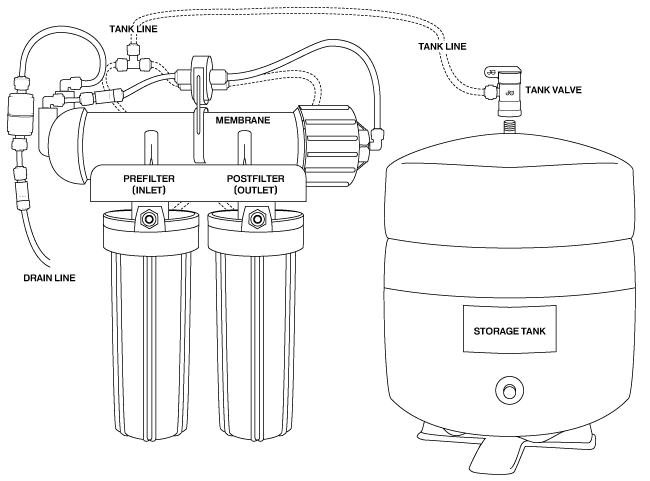Reverse Osmosis Shutoff Problems
Here is a typical customer question regarding an undersink reverse osmosis unit that doesn’t seem to be shutting off properly.
In the past week or so we’ve noticed a dramatic uptick — or trickle — of the filter. That is, we’ve been hearing sometimes for a couple hours at a time, for a week every day, what I’m calling the usual but much less frequent “back flow” into the drain pipe that happens during filtration under normal conditions. Whereas it used to be heard only once a month — in other words, so infrequently that we almost didn’t notice it.
The “backflow” that the RO owner describes is actually the unit’s normal flow to drain. Whether you hear it or not, there is always a trickle of water running to the drain while the unit is filling the storage tank. The drain water’s function is to carry away the impurities that have been rejected by the RO membrane. The trickle to drain happens when the unit is making water to fill the tank. When the tank is full, it stops.
RO Units Don’t Follow Human Logic
There are a number of reasons why you start hearing water run into the drainpipe when you have not heard it before. The most common are a change in water pressure or a change in temperature, causing the water to fall a bit differently into the drain pipe. When drain water slides down the wall of the pipe, you don’t hear it, but if the pressure is a bit stronger it can fall into a small pool of water that has gathered in the pipe and you’ll hear it fall. (If the drain saddle is installed on a horizonal rather than a vertical pipe, you will hardly ever hear the drain flow.)
If it sometimes takes much longer than you would expect to fill the tank, that’s usually because the unit’s production was shut off prematurely with the tank only partially full. The next time the unit begins making water, it will take longer than you expect to refill the storage tank. Here’s a common situation. The unit is filling the tank when an event like a toilet flush or a shower lowers incoming pressure and the production stops because the shutoff system thinks that the tank is full. (Yes, I know, RO units don’t think.) The way that the shutoff system determines the amount of water in the tank is by monitoring the pressure inside the tank and comparing it to the pressure of the tap water going into the unit. The unit fills the tank until the pressure in the tank equals about 2/3 of the pressure of the inlet water. If the inlet pressure goes down (as happens when a toilet is flushed), the production of water to fill the tank can be interrupted. The next time there is a demand for water (e.g., the RO faucet is opened), the pressure in the storage tank goes down, production starts. In this case it will take a lot longer to top off the tank than you would expect.
To Determine If There Is a Problem
The first thing to do is to determine if the shutoff system is working.
Probably the easiest way to determine if the system is working is before going to bed to run enough water through the unit to start production, then check it the next morning. If it has shut off during the night everything is probably working fine.
A quicker way is to turn off the valve on top of the storage tank (off is with the valve handle at right angles with the tube), then open the countertop RO faucet. The water should run at a uniform trickle or small stream. Next, turn off the faucet. Water should stop running to drain within 3 or 4 minutes. If it stops production and keeps it off, the shutoff system is working fine. Turning off the tank valve simulates a full tank.
If water continues to run with the tank valve closed, the unit needs attention. The most likely parts that need replacement are the hydraulic shutoff valve (the disc-shaped part mounted on the membrane housing that has 4 tubes) or, less likely, the check valve (one way valve) in the permeate tube. It is the small cigar-shaped item in the short tube that connects the left end of the membrane housing with the shutoff valve.
Red Flag
If the water you hear in the drain line sounds more like a rushing river than a gentle trickle and it never stops, turn off the inlet water to the unit and leave it off until a repair is made. The offending part is the flow restrictor. That’s the larger of the two cigar-shaped items in the drain tube.





